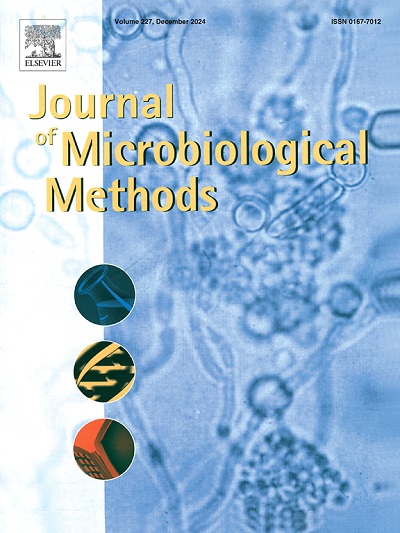MFDF-UNet: Multiscale feature depth-enhanced fusion network for colony adhesion image segmentation
IF 1.9
4区 生物学
Q4 BIOCHEMICAL RESEARCH METHODS
引用次数: 0
Abstract
Colony counting plays a crucial role in evaluating food quality and safety. The segmentation of colony adhesion images can significantly enhance the accuracy of food safety assessments. To achieve high-precision segmentation of colony adhesion images, this paper presents a novel multi-scale feature deep-enhanced fusion network MFDF-UNet, specifically designed for colony adhesion image segmentation. The core of the network lies in the design of a self-similar fusion fractal structure, which recursively integrates layers to enhance the network's ability to extract, integrate, and transfer multi-scale feature information. The DEC (depth-enhanced connectivity) units and PF (progressive fusion) modules in each stage progressively accumulate detailed features, thus improving the network's capacity to handle complex structures. Additionally, the design strengthens the information transfer between different layers, ensuring consistency of features across multiple layers. This reduces the imbalance in feature information transfer that can occur when certain regions of the image contain prominent edges, textures, or structural features, while other areas are relatively blurred or lack distinct features.The MFDF-UNet model achieved an average segmentation accuracy of 77.95 %, precision of 97.55 %, and a mean intersection-over-union (mIoU) of 57.94 % on the AGAR-based hybrid colony adhesion segmentation test dataset. Compared to other deep learning methods, such as PSPNet, DeepLabv3+, SegFormer, YOLOv8, U-Net, and ResNet, MFDF-UNet outperforms the highest-performing ResUNet by 7.53 % in segmentation accuracy, improves precision by 1.5 %, and surpasses ResUNet by 4.82 % in mIoU.Although our model requires slightly more parameters and training time, the improvements in segmentation accuracy and image quality sufficiently justify the additional cost, demonstrating its potential for practical applications in colony adhesion segmentation.
MFDF-UNet:用于群体粘附图像分割的多尺度特征深度增强融合网络
菌落计数在食品质量安全评价中起着至关重要的作用。菌落粘附图像的分割可以显著提高食品安全评价的准确性。为了实现集落粘附图像的高精度分割,本文提出了一种专门用于集落粘附图像分割的新型多尺度特征深度增强融合网络MFDF-UNet。该网络的核心在于设计了自相似的融合分形结构,通过递归层叠,增强了网络对多尺度特征信息的提取、整合和传递能力。每个阶段的深度增强连接(DEC)单元和渐进融合(PF)模块逐步积累细节特征,从而提高网络处理复杂结构的能力。此外,该设计加强了不同层之间的信息传递,确保了多层特征的一致性。这减少了当图像的某些区域包含突出的边缘、纹理或结构特征,而其他区域相对模糊或缺乏明显特征时可能发生的特征信息传递的不平衡。MFDF-UNet模型在基于agar的杂交菌落粘附分割测试数据集上的平均分割准确率为77.95%,精密度为97.55%,平均交叉超集(mIoU)为57.94%。与PSPNet、DeepLabv3+、SegFormer、YOLOv8、U-Net和ResNet等其他深度学习方法相比,MFDF-UNet在分割精度上比性能最高的ResUNet提高了7.53%,精度提高了1.5%,在mIoU上比ResUNet高出4.82%。虽然我们的模型需要更多的参数和训练时间,但分割精度和图像质量的提高足以证明额外的成本是合理的,这表明了它在菌落粘附分割中的实际应用潜力。
本文章由计算机程序翻译,如有差异,请以英文原文为准。
求助全文
约1分钟内获得全文
求助全文
来源期刊

Journal of microbiological methods
生物-生化研究方法
CiteScore
4.30
自引率
4.50%
发文量
151
审稿时长
29 days
期刊介绍:
The Journal of Microbiological Methods publishes scholarly and original articles, notes and review articles. These articles must include novel and/or state-of-the-art methods, or significant improvements to existing methods. Novel and innovative applications of current methods that are validated and useful will also be published. JMM strives for scholarship, innovation and excellence. This demands scientific rigour, the best available methods and technologies, correctly replicated experiments/tests, the inclusion of proper controls, calibrations, and the correct statistical analysis. The presentation of the data must support the interpretation of the method/approach.
All aspects of microbiology are covered, except virology. These include agricultural microbiology, applied and environmental microbiology, bioassays, bioinformatics, biotechnology, biochemical microbiology, clinical microbiology, diagnostics, food monitoring and quality control microbiology, microbial genetics and genomics, geomicrobiology, microbiome methods regardless of habitat, high through-put sequencing methods and analysis, microbial pathogenesis and host responses, metabolomics, metagenomics, metaproteomics, microbial ecology and diversity, microbial physiology, microbial ultra-structure, microscopic and imaging methods, molecular microbiology, mycology, novel mathematical microbiology and modelling, parasitology, plant-microbe interactions, protein markers/profiles, proteomics, pyrosequencing, public health microbiology, radioisotopes applied to microbiology, robotics applied to microbiological methods,rumen microbiology, microbiological methods for space missions and extreme environments, sampling methods and samplers, soil and sediment microbiology, transcriptomics, veterinary microbiology, sero-diagnostics and typing/identification.
 求助内容:
求助内容: 应助结果提醒方式:
应助结果提醒方式:


